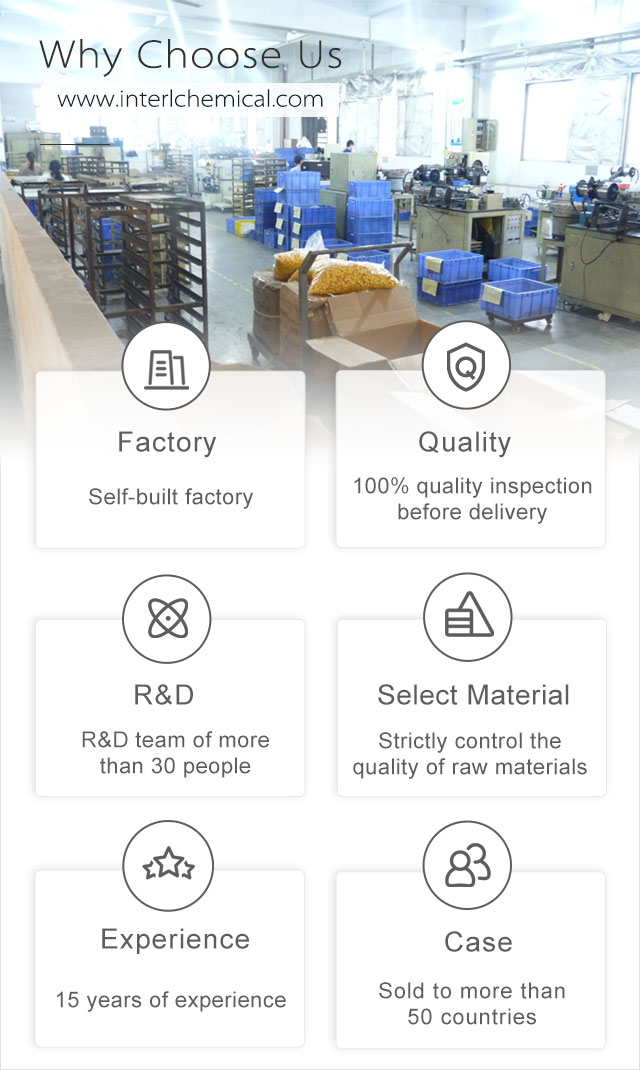





Related Attributes
Product details
Glutaraldehyde liquid is an important saturated straight-chain aliphatic cluster dibasic aldehyde, and despite many reports of Glutaraldehyde CAS 111-30-8, cross-linking of Glutaraldehyde Raw Materials has many advantages and has been accepted for clinical applications. Although Glutaraldehyde Raw Materials is widely used in the pharmaceutical industry as well as in the biomedical field, its toxicity, irritation and environmental pollution cannot be ignored. Glutaraldehyde liquid has a wide range of industrial applications, first of all, it is a fast, efficient, broad-spectrum bactericide, widely used in petrochemical, paper, metal processing, oil field water injection and other fields, Glutaraldehyde CAS 111-30-8 is also an intermediate in organic synthesis, tanning agent in the tanning industry, protein crosslinking agent.

Applications / Functions of Glutaraldehyde liquid
Glutaraldehyde CAS 111-30-8 has a wide range of applications in industry, first of all, it is a fast, efficient, broad-spectrum fungicide, widely used in petrochemical, papermaking, metal processing, oil field water injection, etc. Glutaraldehyde is also an intermediate in organic synthesis, tanning agent in tanning industry, protein crosslinking agent.
Glutaraldehyde liquid is used in disinfection, pharmaceuticals, tanning, and as a film-firming agent for electron microscopes and color picture tubes.Glutaraldehyde liquid is used in the production of the central excitatory drug sanguinarine hydrochloride.Glutaraldehyde Raw Materials is a fast-acting, broad-spectrum chemical sterilizing agent, which can be used as an antiseptic or as an antimicrobial agent at low concentrations at room temperature. Glutaraldehyde aqueous solution in low concentration at room temperature can show activity against many microorganisms, and has a highly sterilizing effect on reproducing bacteria, viruses, mycobacteria, pathogenic molds and bacterial spores, and has very low toxicity to humans.It has been claimed that formaldehyde was used at the beginning of the century, and that chemical germicidal disinfectants such as ethylene oxide were used in the 1930s, and that Glutaraldehyde is currently the third milestone.In 1973, the World Health Organization (WHO) Push the deposit of three products as a disinfectant for hepatitis B virus. Among the known aldehydes, glutaraldehyde is one of the best protein cross-linking agent, the cross-linking is characterized by high activity, fast reaction, high binding amount, stable product, resistance to boiling water, acid and enzyme, so the leather tanned with Glutaraldehyde Raw Materials has excellent resistance to perspiration, heat and soap washing.

Physicochemical Property of Glutaraldehyde liquid
Glutaraldehyde Raw Materials is colorless transparent oily liquid, easily soluble in water and ether, ethanol and other organic solvents, melting point -14 ℃ boiling point 188 ℃ decomposition, refractive index (25 ℃) 1.4330, non-flammable. 25% of the aqueous Glutaraldehyde relative density of 1.066 (20 ℃), melting point -5.8 ℃, boiling point of 101 ℃, has a strong Irritating. It has aromatic flavor, active nature, volatile, polymerization and oxidation.Glutaraldehyde liquid can cross-link with proteins, used for tanning leather, can obtain excellent washing resistance, sweat resistance into leather.

production methodprocess of Glutaraldehyde liquid
At present, the synthesis method of Glutaraldehyde liquid mainly includes pyridine method, pentanediol oxidation method, reduction method, pyran method, cyclopentene oxidation method, pyridine method is to reduce dihydropyridine with sodium metal and methanol, and then open the ring of pentanediamine by hydroxylamine hydrochloride to make pentanedoxime, then decompose glutaraldehyde with sodium nitrite and hydrochloric acid, the method has a long process route, high consumption, high pollution, and the high cost is no longer suitable for production. Pentanediol oxidation method, the depth of oxidation of the reaction is not easy to control, and glutaraldehyde is very easy to oxidize, resulting in the existence of low product yields, high cost and other determinations; Cyclopentene oxidation method, the use of acid-catalyzed hydrogen peroxide oxidation of cyclopentadiene, along with the study of non-homogeneous catalysts, the method embodies a great potential, but at present there is still a small number of catalysts set, the shortcomings of the lower conversion rate of glutaraldehyde, temporarily unable to meet the requirements of industrialization Pyran method, with acetylene and fatty alcohols to produce vinyl ether, and then vinyl ether and acrolein reaction to synthesize 2-alkoxy-3.4-dihydropyran, and then hydrolyzed to glutaraldehyde. The pyran method is relatively mature, with mild reaction conditions, simple operation, good product quality, high yield, little environmental pollution, and suitable for industrial production.
Vinyl ethyl ether and acrolein were added to the reaction kettle, cooled to 5 ℃, added zinc bromide, closed stirring, slowly warmed up, and held at 48 ~ 53 ℃ for 3 h. Cooled to 25 "E: After cooling, washed with water to separate the layers, distillation of the organic layer, the collection of 80 ~ 82 ℃ (10.67 kPa) fractions, which is 2-ethoxy-3,4-dihydropyran, yield 66%. Water, hydrochloric acid and the above intermediates were added to the hydrolysis pot, hydrolyzed with stirring for 1h, and left to stand for 0.5h to obtain glutaraldehyde solution, and the ethanol was evaporated to obtain a 25% aqueous solution. Neutralized with sodium bicarbonate, saturated with salt, and then extracted with ether 2 times. The extract was recovered from the ether and then distilled under reduced pressure to collect the fraction at 75-8l °C (2.0 kPa), which was Glutaraldehyde liquid.
By acrolein and vinyl ether cyclization for 2-ethoxy-3,4-dihydropyran added to the reaction pot, closed stirring for 1h, stand for half an hour, that is, Glutaraldehyde solution, the ethanol will be evaporated, so that 25% solution. Or add sodium bicarbonate to neutralize, saturated with table salt, and then extracted with ether 2 times, after recovery of ether, distillation under reduced pressure, collect 75-81 ℃ (2kPa) fractions, to obtain a pure product. In addition, reduce pyridine to dihydropyridine, then treat with hydroxylamine to get glutaraldehyde, and finally use sodium nitrite and hydrochloric acid to make the reaction of glutaraldehyde to Glutaraldehyde CAS 111-30-8. The conversion rate of this method can be up to 90%.
Why choose us?

HRK Factory

About Shipping

Pharmaceutical Intermediate manufacturers
©2023 Xi'an Henrikang Biotech Co., Ltd.,